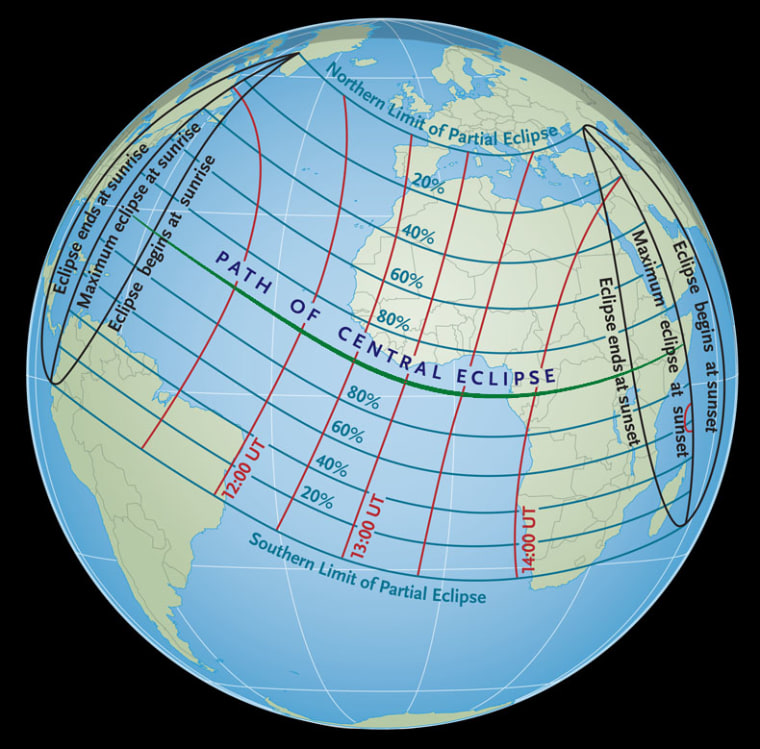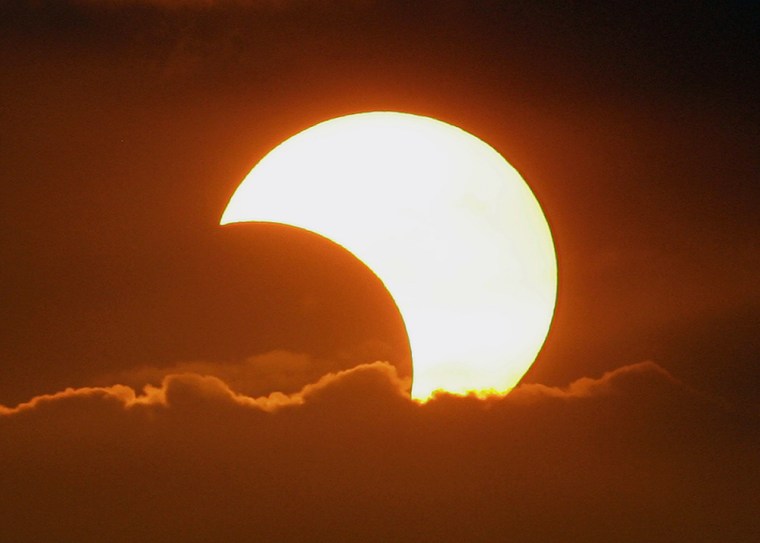Got eclipse glasses? If you're on the East Coast of the U.S., you might want to get 'em — so you can try catching a glimpse of a solar eclipse at sunrise on Sunday.
And no matter where you are, you'll want to be watching the Web as well — so you can catch the show when it's totally at its best.
Sunday's eclipse is a strange one, known as a hybrid. Millions of observers on the eastern edge of the America, in southern Europe and nearly all of Africa have the potential to see a partial eclipse. Over a narrow strip of the western Atlantic, there'll be an annular eclipse, with a tiny portion of the sun's disk remaining visible as a "ring of fire." But as time goes on, the eclipse will turn total: Skywatchers along a thin band of African territory, stretching from Gabon to Somalia, could see a completely blacked-out sun.
Only 5 percent of all eclipses are annular-total hybrids. The most recent one occurred back in 2005. All solar eclipses involve the moon getting right in front of the sun and casting its shadow on our planet. But here's why Sunday's hybrid eclipse is special: During the course of the day, the moon's distance from the spot where its shadow falls on Earth changes just enough to make the transition from leaving some of the sun exposed, to covering up the entire disk.
For detailed information about the eclipse's track, check out Eclipse-maps.com, NASA's eclipse website and this interactive eclipse map from Xavier Jubier.

In the partial eclipse zone
For East Coasters and others in the partial-eclipse zone, here's the important thing: Don't gaze at the sun without proper eye protection.
You can buy special eclipse-viewing filters at planetariums or science centers. You can look through No. 14 welding glass. You can make a "pinhole camera," hold out a colander or knit your fingers together to create projected images of the crescent sun. You can hook up with a local astronomy club that has the proper viewing gear. But trying to see a partial solar eclipse with unprotected eyes will just lead to vision problems.
Technically speaking, the partial eclipse could be visible as far inland as, say, Tennessee. Sky & Telescope projects that 57 percent of the sun's diameter could be covered over at sunrise in Boston, 48 percent in New York, 44 percent in Philadelphia, 35 percent in Washington, and 36 percent in Miami. But you'd have to have a clear view of a flat horizon — and no matter where you are on the East Coast, the partial eclipse will be over within an hour after sunrise. (Use this TimeandDate.com calculator to find out when the sun rises in your locale, and remember that daylight saving time ends on Saturday night.)
Watching it online
All these issues about logistics and safety go away if you're watching the eclipse online. And unless you're in Africa, the only way you'll see totality in real time is via the Web.
Totality is well worth witnessing: When the sun's disk is fully covered, the delicate outer solar atmosphere — known as the corona — can be seen gleaming against the black sky. The total phase will be relatively short on Sunday, lasting somewhere between a second and a minute or so.
The Slooh virtual observatory plans to broadcast video feeds from telescopes in Gabon, Kenya and the Canary Islands. Slooh's host and technical officer, Paul Cox, has joined an expedition to Kenya and will be participating in three and a half hours of live coverage beginning at 6:45 a.m. ET Sunday. You can also watch the show via Slooh's iPad app.
“This will be the most difficult eclipse we’ve covered at Slooh over the years," Cox said in a news release. "Our expedition will be made in a series of 4x4 vehicles carrying our delicate observation equipment across some of the harshest terrain in Africa. After three days across country, we’ll be setting up camp near the home of the largest population of crocodiles in the world — Lake Turkana."
Slooh's show will feature commentary from Cox as well as astronomer Bob Berman, documentary filmmaker Duncan Copp and other guests. Viewers can email questions in advance to coxy@slooh.com, or tweet questions to the panel during the broadcast using the Twitter hashtag #solareclipse. The eclipse should reach totality at Lake Turkana around 9:25 a.m. ET.
Another expedition is setting up on the shores of Lake Turkana with backing from BRCK, an African venture that produces Internet connectivity devices. BRCK's team members are planning an eclipse webcast, and they're already posting updates on the operation to Twitter, Flickr, Instagram and the Web.
More TV coverage may be available via Gabonese television, Kenya's KTN or other African outlets. And after the eclipse is over, there should be lots of great images to see on SpaceWeather.com. Did you snap a picture? Share it with us via the NBC News Facebook page or tweet it with the hashtag #NBCeclipse.
More about solar eclipses:
- Flash interactive: How a solar eclipse happens
- Spectacles donated for Africa's eclipse spectators
- Slideshow: Greatest hits from solar eclipses
- America's 2017 total eclipse already sparks interest
- NBC News archive on eclipses
Alan Boyle is NBCNews.com's science editor. Connect with the Cosmic Log community by "liking" the NBC News Science Facebook page, following @b0yle on Twitter and adding +Alan Boyle to your Google+ circles. To keep up with NBCNews.com's stories about science and space, sign up for the Tech & Science newsletter, delivered to your email in-box every weekday. You can also check out "The Case for Pluto," my book about the controversial dwarf planet and the search for new worlds.
